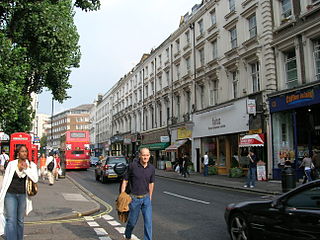Course
Rising from several sources in Hampstead, [1] and Brondesbury Park, [2] the river or drain flows south through Kilburn (also the name of the river at that point) running west along Kilburn Park Road and then south along Shirland Road. After crossing Bishops Bridge Road, the river continued more or less due south, between what is now Craven Terrace and what is now Gloucester Terrace. At this point, the river was known until the early 19th century as the Bayswater rivulet and from that it gave its name to the area now known as Bayswater. Originally Bayswater was the stretch of the stream where it crosses Bayswater Road, "Bayards Watering" in 1652 and "Bayards Watering Place" in 1654. It is said that there is a reference to Bayards Watering Place as early as 1380. There were a few houses at this spot in the eighteenth century and, it seems, a man called Bayard used or offered it as a watering place for horses on this road (formerly Uxbridge Road). The river entered Hyde Park at what is now the Serpentine and is within the park joined by a tributary, Tyburn Brook. The Serpentine was formed in 1730 by building a dam across the Westbourne at the instigation of Queen Caroline, wife of George II, to beautify the royal park. The Westbourne ceased to provide the water for the Serpentine in 1834, [3] as the culverted Westbourne had become the most convenient main sewer and the Serpentine is now supplied from three boreholes from the upper chalk underneath Hyde Park. [4] The Serpentine was widely imitated in parks and gardens nationwide. [4]
The Westbourne left Hyde Park (both before and after it had been dammed to form the Serpentine) at Knightsbridge which was originally a bridge over the Westbourne itself. It is recorded that, in the year 1141, the citizens of London met Matilda of England (Queen Maud) at this bridge. The river ran from Knightsbridge south under Bourne Street, SW1 and followed very closely the boundary between the City of Westminster and the Royal Borough of Kensington and Chelsea, [n 1] joining the River Thames at Chelsea. [5]
The waters of the Westbourne or Bayswater were originally pure and in 1437 and 1439 conduits were laid to carry water from the Westbourne into the City of London, for drinking. In the 19th century, however, the water became foul by its use as a sewer, and the rise of the water closet as the prevailing form of sanitation. [6]
When west Belgravia, east Chelsea and Paddington were developed, it was becoming obvious the river would have to remain a combined or foul sewer, with a certain storm element until such time as surface water drains (if ever) were built upstream. Pipes were therefore wrought in the early part of the 19th century with larger successors completed in the 1850s. The Westbourne is one of the lost rivers of London.
The storm drain, combined sewer, pipe of the lower course can still be seen running above the platform of Sloane Square tube station. [7] Made, in the 19th century, of riveted sections it is below the ceiling towards the end of the platforms closest to the exits. The station was badly bombed during the Bombing of London in November 1940 but the pipe was not damaged.
After flowing beneath the eastern lands of the Royal Military Hospital Gardens and beneath a corner of Chelsea Barracks, the drain was in all but exceptional storms entirely designed to be received by the Joseph Bazalgette-designed Northern Low Level Sewer. As some of its foul content overwhelms the system with further inflows from the west, an improvement, the Thames Tideway Scheme tunnel will enable that sewer to continue to cope. [8]
A clearance in sand against the tideway is about 300 yards (270 m) west of Chelsea Bridge. An emergency combined sewer overflow also called the Ranelagh Sewer, is obvious except at high tide. The combined sewer aims to be caught only by two intercept sewers capable of its flow, the Middle Level Sewer and the Northern Low Level Sewer in the London sewerage system. [6]
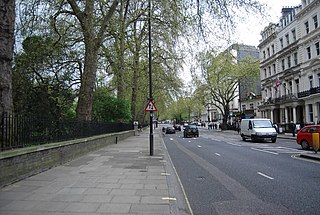
Bayswater is an area within the City of Westminster in West London. It is a built-up district in the West End with a population density of 17,500 per square kilometre, and is located between Kensington Gardens to the south, Paddington to the north-east, and Notting Hill to the west.

Kilburn is an area of north west London, England, which spans the boundary of three London Boroughs: Camden to the east, City of Westminster, and Brent to the west. There is also an area in the City of Westminster known locally as "Mozart" that along with Queens Park and Kensal Green are known as West Kilburn, which sometimes is treated as a distinct locality. Kilburn High Road railway station lies 3.5 miles (5.6 km) north-west of Charing Cross.

Kensington Gardens, once the private gardens of Kensington Palace, are among the Royal Parks of London. The gardens are shared by the City of Westminster and the Royal Borough of Kensington and Chelsea and sit immediately to the west of Hyde Park, in western central London known as the West End. The gardens cover an area of 107 hectares. The open spaces of Kensington Gardens, Hyde Park, Green Park, and St. James's Park together form an almost continuous "green lung" in the heart of London. Kensington Gardens are Grade I listed on the Register of Historic Parks and Gardens.

The Serpentine is a 40-acre (16 ha) recreational lake in Hyde Park, London, England, created in 1730 at the behest of Queen Caroline. Although it is common to refer to the entire body of water as the Serpentine, the name refers in the strict sense only to the eastern half of the lake. Serpentine Bridge, which marks the boundary between Hyde Park and Kensington Gardens, also marks the Serpentine's western boundary; the long and narrow western half of the lake is known as the Long Water. The Serpentine takes its name from its snakelike, curving shape, although it only has one bend.
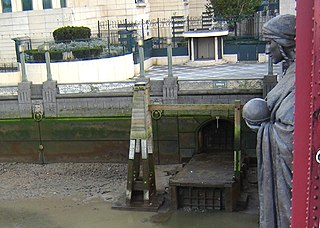
The River Effra is a former set of streams in south London, England, culverted and used mainly for storm sewerage. It had been a tributary of the Thames. Its catchment waters, where not drained to aquifer soakaways and surface water drains, have been incorporated into 1850s-built combined sewer sectors, devised by Sir Joseph Bazalgette. One drains Peckham, the other Brixton, then intended to flow towards Peckham. These generally flow east to be treated at Crossness.
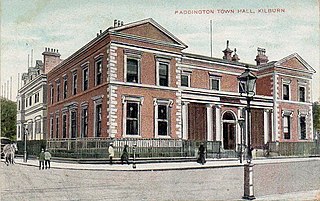
Paddington was a civil parish and metropolitan borough in London, England. It was an ancient parish in the county of Middlesex, governed by an administrative vestry. The parish was included in the area of responsibility of the Metropolitan Board of Works in 1855 and became part of the County of London in 1889. The parish of Paddington became a metropolitan borough in 1900, following the London Government Act 1899, with the parish vestry replaced by a borough council. In 1965 the borough was abolished and its former area became part of the City of Westminster in Greater London.

The Thames Embankment is a work of 19th-century civil engineering that reclaimed marshy land next to the River Thames in central London. It consists of the Victoria Embankment and Chelsea Embankment.

The London sewer system is part of the water infrastructure serving London, England. The modern system was developed during the late 19th century, and as London has grown the system has been expanded. It is currently owned and operated by Thames Water and serves almost all of Greater London.

The Northern Outfall Sewer (NOS) is a major gravity sewer which runs from Wick Lane in Hackney to the Beckton Sewage Treatment Works in east London. Most of it was designed by Joseph Bazalgette, as a result of an outbreak of cholera in 1853 and the "Great Stink" of 1858.
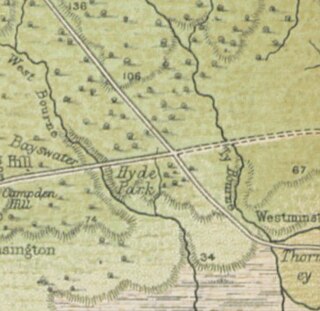
Tyburn Brook was a small tributary stream to the West Bourne or Westbourne and ran mainly in Hyde Park for a few hundred metres south by south-west. It has lost its catchment to natural drainage into the gravelly topsoil and to surface water, foul and in early Victorian style combined sewers and its small collect, its source remains beneath the earth to feed into a mixture of these. The Serpentine, having been the Westbourne's main showing is now fed by three boreholes instead. It is not to be confused with the much longer Tyburn, Ty Bourne or River Tyburn, but frequently was confused until the early 19th century as both were well west of the walls of the City of London.

The River Tyburn was a stream in London, England. Its main successor sewers emulate its main courses, but it resembled the Colne in its county of Middlesex in that it had many distributaries. It ran from South Hampstead, through Marylebone, Mayfair, St James's parish/district and Green Park to meet the tidal Thames at four sites, grouped into pairs. These pairs were near Whitehall Stairs, and by Thorney Street, between Millbank Tower and Thames House. Its much smaller cousin, the Tyburn Brook, was a tributary of the Westbourne and the next Thames tributary.

Stamford Brook was a tributary of the Tideway stretch of the River Thames in west London supplied by three headwaters. Historically used as an irrigation ditch or dyke, the network of small watercourses had four lower courses and mouths.

Chelsea Embankment is part of the Thames Embankment, a road and walkway along the north bank of the River Thames in central London, England.
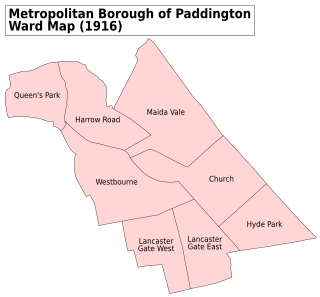
Westbourne is an area in West London. It has a manorial history spanning many centuries, within a more broadly defined Paddington, before shedding its association in the mid-19th century. It is named after the west bourne, West Bourne, or River Westbourne, a Thames tributary which was encased in 19th-century London in the 1850s. The spring-fed stream and associated manor have led to the place names Westbourne Green, Westbourne Park and more narrowly: Westbourne Gardens, Westbourne Grove, Westbourne Park Road, Westbourne Park tube station, Westbourne Studios and the name of a public house.
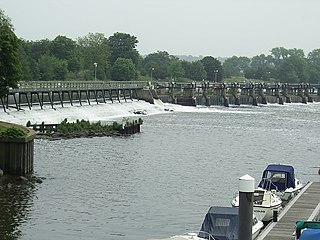
The Tideway is a part of the River Thames in England which is subject to tides. This stretch of water is downstream from Teddington Lock. The Tideway comprises the upper Thames Estuary including the Pool of London.

The Falconbrook was a stream that rose in Balham and Tooting, draining much of those parishes then the south and west of the larger district of Battersea including Clapham Junction to enter the London reaches of the Thames. Before doing so, it briefly formed the border of Wandsworth Town, reflected in the SW11/SW18 boundary today.

Edgware Road Tube schemes covers a number of proposals to build an underground railway in London, UK at the end of the 19th century. Each scheme envisaged building some form of rail tunnel along the Edgware Road in north-west London towards Victoria railway station.










